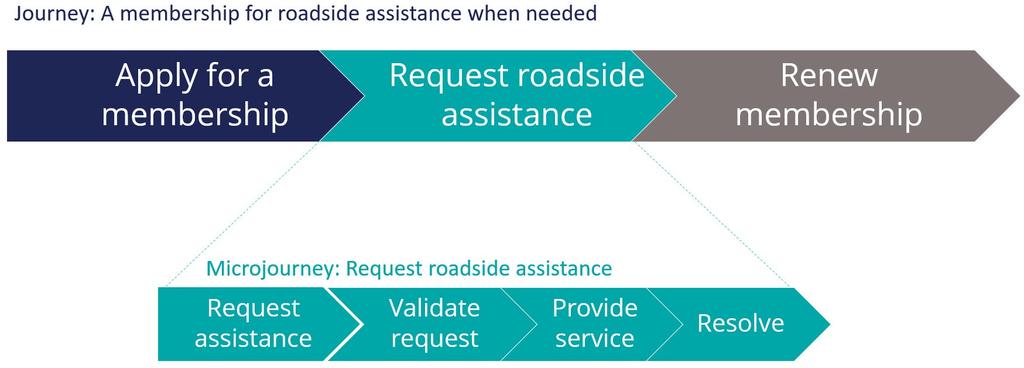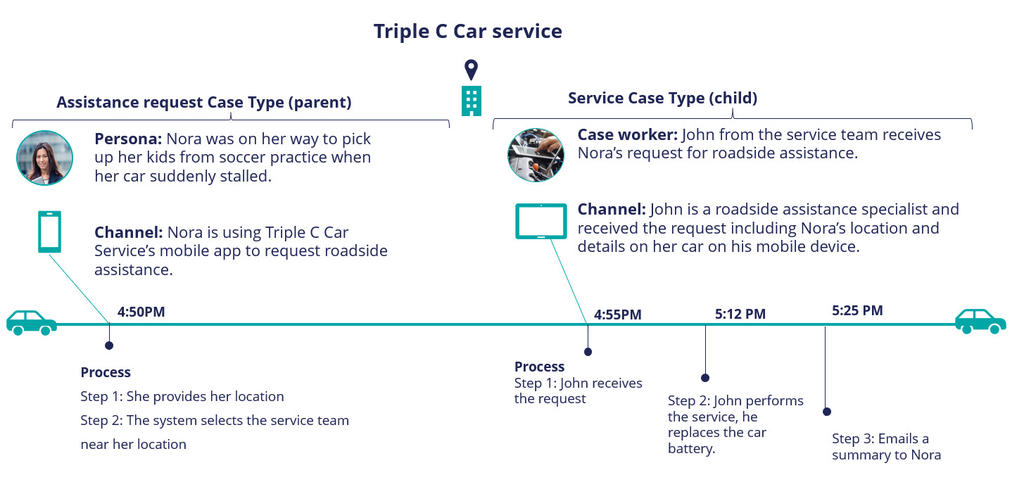
Microjourney defined
Journey and Microjourney defined
The concept of a Microjourney™ is fundamental to the Pega Express™ delivery approach; it is one of the three pillars. But before you learn about Microjourneys, you must start with the definition of a journey.
"A journey is the series of interactions between a customer and an organization that occur as the customer pursues a specific goal." — Forrester
Within a Pega Platform™ project, a business customer's journey:
- May represent multiple and related business outcomes
- May cross multiple teams and channels (multiple touchpoints)
- May be too big to deliver in 60-90 days
Note: An entire journey can be too large to achieve in one release. That is when a Microjourney becomes relevant.
In the following image, you see an example of a journey and a Microjourney.
Journey: A membership for roadside assistance when needed
- Apply for a membership
- Request roadside assistance
- Renew membership
Microjourney: Request roadside assistance
- Request Assistance
- Validate request
- Provide service
- Resolve
Microjourney explained
A Microjourney s a part of the overall customer journey that achieves all or a subset of the required business outcomes. Microjourneys are the life cycles, or units of work, that deliver a meaningful result to customers and users. Identifying the stages of a Microjourney provides the team with enough structure to organize and optimize the processes needed to perform the work.
In Pega Express™, a Microjourney can be:
- Delivered to more than one customer type (persona)
- Delivered by one or more channels
- Achieved by one or more case types
- Delivered to one channel and one persona, and then re-used for a different channel or persona
- Implemented in around 60 days — the perfect size for an application release
In the following image and the information that follows, you will learn about the Microjourney in terms of the customer story.
Triple C Car service
Organization providing road side assistance to members
Goal
Nora wants to feel safe when she travels and want to know she has support when her car breaks down.
Microjourney
Apply for membership
Nora is driving her kids to many after school activities. She applies for a membership from Triple C Car Service using the web portal from her home computer. She feels relieved to know there is someone to help her if the car breaks down.
Microjourney
Request road side assistance
Nora was on her way to pick up the kids from soccer practice when her car suddenly stalled. She finds Triple C Car Service mobile app to request road side assistance.
Microjourney
Renew membership
Nora has used the service several times and received a renewal notification. She is pleased with the services she has received and renews her membership using her mobile phone.
Journey and Microjourney examples
Follow the experience that Nora (persona) has when her car breaks down on her way to collect her children from soccer practice. Nora is a member of Triple C Car breakdown assistance program, and help is on the way.
Next, view more detail about what happens when her car breaks down. Notice the various people involved, the different processes, and the different channels Nora can use to contact Triple C Car services.
In the following image, you learn more about how a Microjourney is broken down into stages and steps.
Triple C Car service
Organization providing road side assistance to members
Assistance request Case Type (parent)
Persona: Nora was on her way to pick up her kids from soccer practice when her car suddenly stalled.
Channel: Nora is using Triple C Car Service’s mobile app to request roadside assistance.
Process
Step 1: She provides her location
Step 2: The system selects the service team near her location
Service Case Type (child)
Case worker: John from the service team receives Nora’s request for roadside assistance.
Channel: John is a roadside assistance specialist and received the request including Nora’s location and details
Process
Step 1: John receives the request
Step 2: John performs the service, he replaces the car battery.
Step 3: Emails a summary to Nora
Business outcome: Nora’s car is fixed and she can pick up her kids from soccer practice.
Microjourney building blocks
You can now see how the roadside assistance Microjourney fits into Nora's overall journey with the company.
The Microjourney logically breaks down into the key building blocks you need to Capture a Microjourney and build a Pega Platform solution by using Pega Express. The building blocks include case types, personas, channels, and supporting data.
In the following image, you see the building blocks of a Microjourney.
- Case Types
- Personas
- Channels
- Data
Microjourney is a business transaction that results in an intermediate or final outcome.
The Microjourney is delivered using Case Types to describe the business transaction between personas and the exchange of data using available channels to achieve a business outcome.
Triple C Car service is an organization providing roadside assistance to members.
Case Types:
- Request Assistance
- Service
Personas:
- Nora
- Service member
Channels:
- Mobile device online
- Tablet device online
Data:
- Nora's location and vehicle information
- Service provided, quantity and cost
Microjourneys and focus
A Microjourney serves as a vehicle for defining the Center-out™ business architecture. It:
- Helps you identify what you are going to build and test
- Focuses on what will change in the application release
- Enables you to manage the release and deliver visible results to the business
By using the concept of a Microjourney, you achieve:
- Speed of implementation – By going live quickly with smaller solutions that represent a Microjourney, your team learns and can improve future iterations of the application.
- Clear scope – Understanding and defining your scope makes it clear to your team and stakeholders what is proposed for each release.
- Reduced risk – Being realistic in your scope reduces risk by ensuring you deliver a solution that delights your clients and their end-user customers.
- Business value – Your Microjourney is sized and scoped to deliver real business outcomes, prioritized to achieve strategic business goals.
Check your knowledge with the following interaction.
This Topic is available in the following Module:
If you are having problems with your training, please review the Pega Academy Support FAQs.
Want to help us improve this content?



